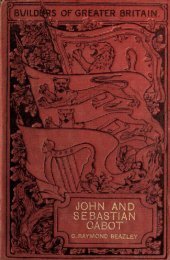st. john of damascus (676-749 - Cristo Raul
st. john of damascus (676-749 - Cristo Raul
st. john of damascus (676-749 - Cristo Raul
You also want an ePaper? Increase the reach of your titles
YUMPU automatically turns print PDFs into web optimized ePapers that Google loves.
"<br />
De<br />
"<br />
"<br />
"<br />
THE "FONS SCIENTLE." 7 I<br />
with the Latins for works <strong>of</strong> this class, as we may see<br />
by the Sententiae <strong>of</strong> Bandinus ;<br />
which resembled<br />
Peter the Lombard s so closely in form, that it. has<br />
been disputed which <strong>of</strong> the two imitated the other. 1<br />
The division <strong>of</strong> Damascenus himself is into one<br />
hundred chapters, possibly meant to correspond with<br />
the hundred sections <strong>of</strong> his De Hasresibus Liber;"<br />
and a separation into four books really breaks the<br />
connection between chapters meant to be consecu<br />
tive ; as, for example, the forty-third and forty-fourth<br />
(on the providence <strong>of</strong> God, and on His foreknow<br />
ledge).<br />
Besides passages from Holy Scripture, which are<br />
largely quoted, though in a way that may <strong>of</strong>ten seem<br />
to us far-fetched, the chief quotations are from<br />
Gregory <strong>of</strong> Nazianzus, and his namesake <strong>of</strong> Nyssa,<br />
Basil, Chryso<strong>st</strong>om, Epiphanius, Nemesius, and some<br />
others. The writings ascribed to Dionysius the<br />
Areopagite should not be left out ;<br />
in particular, the<br />
.<br />
Divinis Nominibus." In fact, the amount <strong>of</strong> his<br />
indebtedness to these and similar writers is greater<br />
than might at fir<strong>st</strong> sight be obvious, from his way <strong>of</strong><br />
using their language at times without troubling to<br />
specify their names. Thus, for example, towards the<br />
end <strong>of</strong> the second chapter, when treating <strong>of</strong> the<br />
impossibility <strong>of</strong> knowing God, or comprehending the<br />
nature <strong>of</strong> the Incarnate Word, he has recourse to the<br />
illu<strong>st</strong>ration used by the Areopagite Div. Norn." c.<br />
("<br />
ii.), namely, the walking upon the sea. The division<br />
into books being, as was said above, in all probability<br />
1<br />
Gieseler, iii., p. 291, n.
















